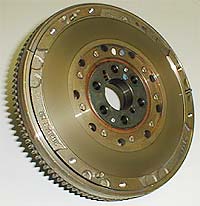
Back Aansitter Afrikaans بادئ Arabic Старцёр Byelorussian Motor d'arrencada Catalan Startér (motor) Czech Startmotor Danish Motoranlasser German Startigilo Esperanto Motor de arranque Spanish استارت Persian

A starter (also self-starter, cranking motor, or starter motor) is a device used to rotate (crank) an internal-combustion engine so as to initiate the engine's operation under its own power. Starters can be electric, pneumatic, or hydraulic. The starter can also be another internal-combustion engine in the case, for instance, of very large engines, or diesel engines in agricultural or excavation applications.[1]
Internal combustion engines are feedback systems, which, once started, rely on the inertia from each cycle to initiate the next cycle. In a four-stroke engine, the third stroke releases energy from the fuel, powering the fourth (exhaust) stroke and also the first two (intake, compression) strokes of the next cycle, as well as powering the engine's external load. To start the first cycle at the beginning of any particular session, the first two strokes must be powered in some other way than from the engine itself. The starter motor is used for this purpose and it is not required once the engine starts running and its feedback loop becomes self-sustaining.

- ^ Gingell, Rachel (8 December 2016). "The John Deere 720 diesel and its innovative pony motor design". Farms.com. Retrieved 28 March 2021.
© MMXXIII Rich X Search. We shall prevail. All rights reserved. Rich X Search